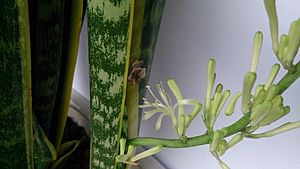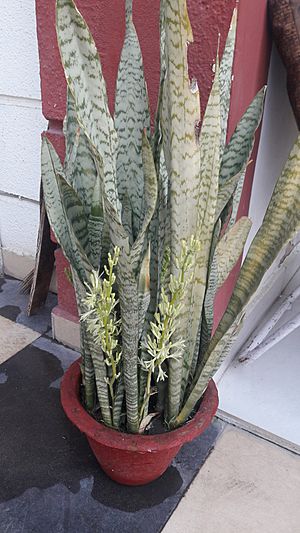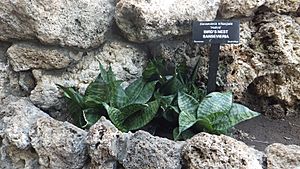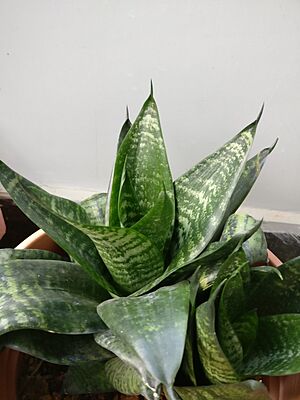Snake plant facts for kids
Quick facts for kids Snake Plant |
|
|---|---|
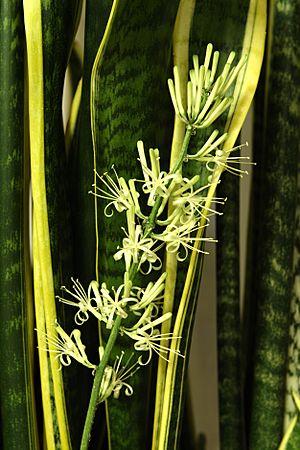 |
|
| Sansevieria trifasciata in flower | |
| Scientific classification | |
| Kingdom: | |
| (unranked): | |
| (unranked): | |
| Order: | |
| Family: |
Ruscaceae Agavaceae
|
| Genus: |
Sansevieria
|
| Species: |
S. trifasciata
|
| Binomial name | |
| Sansevieria trifasciata Prain., 1903
|
|
The Dracaena trifasciata plant is often called the "snake plant" or "mother-in-law's tongue." It is a very tough and easy-to-grow plant. This plant originally comes from dry parts of Africa, like a desert plant.
It is a type of succulent, which means its thick leaves can store a lot of water. Because of this, you do not need to water it often. The snake plant can also grow well in places with low sunlight and can stay in the same pot for many years. It actually prefers less water rather than too much!
Contents
What Does a Snake Plant Look Like?
The snake plant is an evergreen perennial plant, meaning it stays green all year and lives for many years. It grows in thick groups, spreading out using special underground stems called rhizomes. These rhizomes can be above or below the ground.
Its stiff leaves grow straight up from the base of the plant. Grown-up leaves are dark green with light gray-green stripes across them. They are usually about 70 to 90 centimeters (27 to 35 inches) long and 5 to 6 centimeters (2 to 2.5 inches) wide. In perfect conditions, a snake plant can even grow taller than 1.8 meters (6 feet)! The name trifasciata means "three bundles," which describes its leaf pattern.
How Snake Plants Breathe
Snake plants have a special way of breathing that helps them live in dry places. They use a process called crassulacean acid metabolism. This allows them to handle drought, which is a long period without rain.
Most plants open tiny pores on their leaves, called stomata, during the day to take in carbon dioxide and release oxygen. But snake plants open their stomata only at night. This stops them from losing water through evaporation in the hot sun. So, they release oxygen at night, which is different from most other plants.
Fun Names for the Snake Plant
The Dracaena trifasciata has many interesting common names. It is often called "mother-in-law's tongue" or "snake plant" because of its long, sharp leaves. Another name is "Saint George's sword."
It is also known as "viper's bowstring hemp." This is because its strong plant fibers were once used to make bowstrings for bows.
Around the world, this plant has different names:
- In China, it is called hǔwěilán, which means "tiger's tail orchid."
- In Puerto Rico, it is lengua de vaca, or "cow's tongue."
- In Japan, it is tora no o, meaning "tiger's tail."
- In Turkey, it is paşa kılıcı, or "pasha's sword."
- In Portugal and Brazil, it is espada de São Jorge, meaning "sword of Saint George."
- In the Netherlands and Belgium, it is "vrouwentong" (women's tongue).
- In Russia, it is "тёщин язык" ("mother-in-law's tongue") and "щучий хвост" ("pike's tail").
Growing and Using Snake Plants
Snake plants are mostly grown as ornamental plants today. This means people grow them because they are beautiful. In warm places, they can grow outdoors. In cooler areas, they are popular houseplants.
They are great for beginners who want to grow houseplants because they are so easy to care for. They do not need much light and do not need to be watered often. In winter, you might only need to water them once every couple of months. Be careful not to water them too much, as their roots can rot easily.
Snake Plants and Air Quality
A study by NASA looked at how well plants can clean indoor air. They found that the snake plant can help remove some harmful chemicals from the air inside buildings. However, it cleans the air very slowly, so you would need many plants to make a big difference.
How to Grow New Snake Plants
You can grow new snake plants in two main ways:
- By taking cuttings from a leaf.
- By dividing the rhizome (the underground stem).
If you use a leaf cutting, the new plant might not have the same cool patterns or colors as the parent plant.
The snake plant contains natural chemicals called saponins. These can cause an upset stomach if eaten by dogs or cats, so it is best to keep pets from chewing on the leaves.
Different Types of Snake Plants
There are many different types of snake plants, called cultivars. Many of these have special variegated leaves, which means they have yellow or silvery-white stripes along their edges.
Some popular types include 'Compacta', 'Goldiana', 'Hahnii', 'Laurentii', 'Silbersee', and 'Silver Hahnii'. The 'Hahnii' type was found in 1939 in New Orleans, Louisiana.
Some snake plant types, like D. trifasciata var. laurentii, 'Bantel's Sensation', and 'Golden Hahni', have won awards from the Royal Horticultural Society for being excellent garden plants.
Cultural Meanings of the Snake Plant
In its home country of Africa, a type of snake plant with yellow tips is linked to Oya, a goddess of storms. In Nigeria, it is often connected to Ogun, a god of war. People use it in special ceremonies to ward off bad luck.
In Brazil, its common name Espada de São Jorge (sword of Saint George) connects it to Saint George, who is also linked to the god Ogun.
Images for kids
See also
 In Spanish: Sansevieria trifasciata para niños
In Spanish: Sansevieria trifasciata para niños


